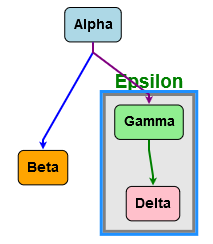Hello, I’m having a problem with groups in my diagram. I am using the CommandHandler Ctrl-G to create new groups based on my selection. My diagram is using a LayeredDigraphLayout and my group template also sets another instance of LayeredDigraphLayout on the group. The group template also uses a placeholder for the member parts.
Everything is working great with one exception. When I move the group it quickly flashes (auto resizes) during the move. When the move is completed it returns to the size I would expect based on the nodes within the placeHolder (the original size before the move).
For example if I have this layout…
N1
|
||||G|||||
| N2 |
| | |
| N3 |
||||||||||
Imagine the links are such N1 -> N2, N2 -> N3 (no links to the group itself). When I move Group G to the right, during the move the node N3 seems to move to the top of the diagram while N2 remains stationary. This causes the link from N2 to N3 to curl back around up to the top and causes the vertical size of G to increase.
If I don’t have that link from N2 -> N3 then the move happens smoothly without causing the group to auto resize.
My setting on the group is to not allow the user to resize it.
I’m using version 1.6.9, the latest download at this time.
